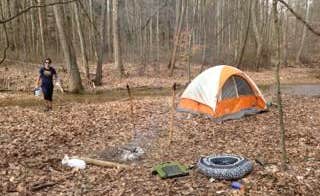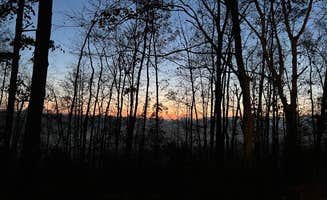Dispersed camping opportunities near Henryville, Indiana extend throughout the Hoosier National Forest's 204,000 acres of rugged terrain. The area features upland hardwood forests with elevations ranging from 400 to 900 feet. During summer months, temperatures average 70-85°F with high humidity levels, while campers should prepare for temperature drops into the 30s during spring and fall nights.
What to do
Hiking challenging trails: The Peninsula Trail offers multiple marked primitive sites along Lake Monroe. "It was an awesome backpacking journey for starters, little bit rough because of the horse riding track but awesome if you love to walk and see nature," notes camper Osiel M. about the Peninsula Trail.
Wildlife watching: Early mornings provide opportunities for spotting white-tailed deer, wild turkey, and various bird species. "Watch out for ticks. My dogs and I got loads of them in April 2020 from Leota to Spurgeon Hollow," warns a Peninsula Trail hiker, emphasizing the need for proper tick protection.
Stargazing opportunities: Sites away from the main roads offer excellent night sky viewing. At Hickory Ridge Primitive Dispersed Campsites, "Very secluded, I pulled in at midnight in a sedan in the winter and i was able to safely find my way. Very nice drive during the day, hiking is fantastic!" according to Jimmy H.
What campers like
Privacy between sites: Campers appreciate the separation between camping spots. "It's really quite only seen a handful of cars drive by and I've stayed here for 2 nights," mentions Ozzie L. about dispersed camping options in the forest.
Natural surroundings: The undeveloped nature of the campsites preserves the wilderness experience. "The entire park is just beautiful. It's very family friendly and quiet. The sites are spacious, and there are a lot of nature things to do," describes Susan C. about Knobstone Trail.
Minimalist setup: Many campers value the back-to-basics approach. "For those of you who don't understand disperse camping this is the perfect site for a tent to camp without anything but what you bring in and take out," explains James W. about rustic camping near Henryville.
What you should know
Road conditions vary: Access to some sites requires navigating unpaved routes. "Beautiful secluded site that is pretty far off of the road, but not too far. There was no traffic or other people in site. I have a promaster conversion and had no trouble making it to this site, however the road was gravel and steep at times," notes Amber R. about Berry Ridge Road - Dispersed Camping.
Water planning essential: Particularly during warmer months, reliable water sources become scarce. "You're never too far from water, although the quality may differ depending on the time of year," advises one experienced hiker.
Limited cellular coverage: Cell service is spotty throughout the forest, with better reception on ridgetops. At remote sites, campers should plan communications accordingly.
Tips for camping with families
Choose accessible sites: For those with young children, locations closer to forest service roads provide easier escape routes if needed. "Campsite #18 has a great view and is large enough for at least 4 tents if you have a big group," recommends Aspen B. about the Peninsula Trail.
Wildlife preparation: Teach children about wilderness safety before arrival. "Solo camped here with my dogs. First time I've ever been camping but this spot was really cool. Clean. Secluded and peaceful, though every night at around 5pm I would hear rustling in the leaves," reports Reuben R.
Pack extra supplies: The remoteness of sites means no quick trips to stores. One camper advises bringing "plenty of drinking water" since springs require significant hiking to reach.
Tips from RVers
Size limitations: Most primitive sites accommodate smaller vehicles only. "At the pond there was a pad of concrete leftover from who knows what. I wouldn't be trying to pull a travel trailer back into here unless it was very small," cautions Steven G. about Sundance Lake Dispersed Camping.
Road clearance considerations: High-clearance vehicles fare better on forest service roads, especially after rainfall. "National forest area with 3ish campsites one of which can accommodate a vehicle. Wooded so no solar or starlink," notes Julie at Sundance Lake.
Limited turnaround space: Some forest roads offer few opportunities to turn larger vehicles around. "A hidden gem. Just a few sites along the road minimum traffic encountered," observes David S. about BerryRidge Road camping areas.




